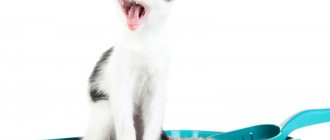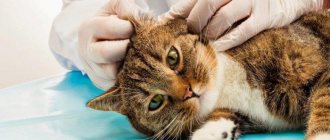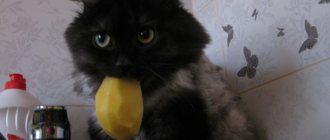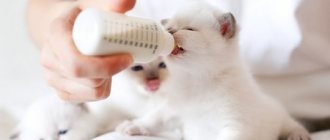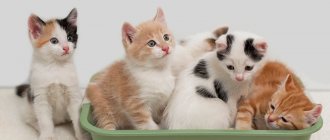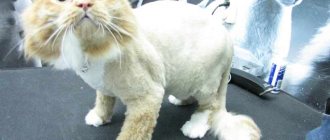It's no secret that pets bring many pleasant moments to their owners. They, in turn, are obliged to carefully monitor the health and good mood of their pets. Proper nutrition and daily care will allow your cat to look just perfect.
Responsible pet owners regularly visit a veterinarian and monitor the health of their pets. Coat care requires special attention. It happens that a cat's hair comes out a lot. What to do? How to help your pet and prevent this from happening in the future?
Causes
First, you should determine why your cat is losing hair and think about whether the negative impact can be eliminated. However, there is no need to panic. If a cat loses a clump of hair, this does not mean that it is dying. The reasons may be different:
Seasonal shedding. Have you noticed that your cat has a lot of hair coming out? What to do? First, take a close look at the calendar. Is your cat not looking sick and hairless, but is actively shedding excess hair? It is likely that she is simply molting. This usually happens twice a year: in autumn and spring. For “apartment” cats that do not go outside, the process may take 2–3 months. There's no need to panic. Instead of the old fur, a new beautiful fur coat will quickly grow.
Dermatitis. It can be allergic and contact. When a cat's fur comes out in clumps and obvious bald patches appear, owners have cause for concern. In the future, bald spots may become covered with scales, turn red and itch. You should immediately see a doctor and determine the cause of the disease. It is likely that this is how the animal reacts to certain foods or new food.
Flea dermatitis. If the resulting bald patches are itchy and covered with crusts and scales, there is reason to suspect a severe reaction to fleas. During this period, the cat’s temperature may rise, and it is very easy to see uninvited “guests” between the hairs.
Skin mite. The disease can be identified by bald paws and muzzle. The hair on the ears also noticeably thins, and throughout the body it becomes dull and unkempt. Self-medication is not enough; you will have to visit a veterinarian.
Lichen. In this case, the hair does not just climb, but falls out in whole pieces. Unsightly bald spots form that quickly increase in size. At the slightest suspicion, you need to show the animal to a doctor as soon as possible.
Stress. A cat can shed heavily in response to new impressions or an unusual environment. The catalyst can be the appearance of other animals in the family, a move, the birth of a baby, the death of the owner, and more.
Avitaminosis. Lack of nutrients, change of feed, seasonal manifestations, lack of certain organic compounds.
Age-related changes. The cat seems to be healthy, but the hair on the ears and face has noticeably thinned out? Your cat is already many years old. In this case, hair loss is associated with poor nutrition of the hair follicles.
Hormonal disbalance. The appearance and thickness of the coat can be affected by pregnancy, estrus, birth and feeding of kittens, and birth control drops and pills that the cat takes.
How to deal with shedding
Depending on the cause of shedding, you can help your pet in different ways. Therefore, it is important to determine the cause first. Not only our advice, but also a veterinarian can help with this. In cases such as worms and dermatitis, contacting a specialist is mandatory. It is advisable to be observed in other cases, because the health of the pet is important. Your pet's coat can be affected by diet, parasites, fleas, hormones, climate and many other factors. Let's look at some of the most common cases:
- Cat shedding due to an unbalanced diet or vitamin deficiency during the off-season can be successfully treated with B12 vitamins;
- In the case of helminthiasis, the doctor himself selects drugs that fight roundworms and, if necessary, restore the balance of the body after exposure to toxins;
- If your cat sheds after castration, vitamins can also help solve this problem. Only a veterinarian can prescribe them.
The reasons for molting can be different. And it is very important to pay attention to this process when it becomes a problem. In fact, shedding occurs naturally. But if there is a change in the animal's normal coat change pattern or year-round hair loss, there are other explanations.
How to diagnose hair loss?
How can you tell if your cat has a lot of hair? What to do and how to help the animal?
It is simply impossible not to notice the problem. Cats with long hair lose fur so actively that literally everything becomes covered with hair. Short-haired breeds shed their hair less noticeably, but it is still noticeable. If the pussy is outwardly alert and cheerful, actively eating and playing, but the number of lost hairs has increased, there is no need to worry. We are most likely talking about a trivial molt.
You should take your pet to the vet immediately if:
- The pet's behavior has changed. He is too active or apathetic, shows aggression, sleeps more than usual, scratches himself or chews out pieces of fur.
- The hair falls out unevenly, and bald patches and bald spots appear.
- Hair loss is accompanied by the appearance of wounds, pustules or scales.
- The cat has dandruff, fungal manifestations or other troubles.
The doctor will make an accurate diagnosis and prescribe appropriate treatment. You may need to get tested.
Why do you need to comb cats?
Over the course of months, unkempt fur results in unsightly tangles. If you continue to ignore the combing procedure, the fur coat will no longer be similar to the previous one, but will turn into a hard shell. Imagine how difficult this will make the animal’s life—you won’t be able to wash yourself or scratch yourself. Why scratch it, the poor animal can’t even stretch properly.
Neglected case
But this is just part of the problem. Next, an inflammatory process will begin to develop under the shell, and for bacteria this situation is simply ideal. As a rule, it is at this moment that the owners begin to fuss, looking for an answer to the question: “Who infected my cat?” Although the thought that all this could have been prevented by brushing the pet daily, of course, will never occur to them.
They will be informed about the need for the procedure by a veterinarian, who will come with a clipper and trim the coat of the once beautiful Angora or Persian under anesthesia. In addition, during the conversation it turns out that the fight against mats was constantly carried out with the help of a special shampoo, the label of which read “To remove mats.” It's worth noting that this is just a publicity stunt. Shampoo for tangles is used only for preventive purposes, and once they appear, the product is absolutely useless and even harmful.
Freeing a cat from tangles
After removing the shell, the veterinarian will explain to the owner that combing should be done daily with special brushes and combs. Moreover, long-haired beauties must go through this procedure several times a day during the molting period. As for their brothers with a short fur coat, you can get by with once every 2 days.
You don't need to bathe your cat often either. Once every 2 weeks is enough for heavy shedding. If the pet itself does not mind, then the procedure can be performed more often.
It is worth saying that tangles are not so catastrophic. The trouble is that the cat will zealously lick the dead hairs. What can you do here - it’s laid down by nature. This cannot be done without the hairs from the mouth getting into the stomach. Can you imagine, if the shedding is intense, and the pussy has long hair, then in what quantities does it penetrate the gastrointestinal tract? Many will ask: “Well, what’s the big deal, just throw up once and that’s it?” Not all. Hairballs that get into the stomach can cause intestinal obstruction, and then it’s not far from the operating table.
The cat clears its stomach of fur
Therefore, combing is a very important procedure, which allows you not only to remove dead hairs, but also parasites, as well as their metabolic products. In addition, regular brushing will help:
- Clean your apartment from fur less often;
- resist eating falling hairs;
- prevent stomach and intestinal congestion;
- speed up blood circulation and metabolism;
- prevent and get rid of tangles;
- grow wool beautiful and strong.
In order for the procedure to be as useful as possible and bring a lot of pleasure to the cat, it should be carried out correctly.
Many cats enjoy brushing
How to help your pet?
Once your doctor determines why your cat is losing hair, treatment should begin immediately. In some cases, you can do without medications. Sometimes it is enough:
- adjust the animal’s diet, add previously missing products to it, remove excess;
- Regularly brush your pet with a special brush and bathe it;
- do not ignore preventive vaccinations;
- walk your pet more often;
- calm the cat, show care and attention when it comes to stressful manifestations;
- choose a special vitamin complex to improve the condition of the coat.
How to treat hair loss?
If hair loss is associated with allergies, the following measures will help:
- identify the allergen, exclude salty and fatty foods from the diet;
- adhere to a special balanced diet recommended by your doctor;
- if you were given dry cat food, it is better to use a medicinal product for wool, recommended for animals prone to dermatitis;
- add special vitamins for wool to food;
- Give antiallergic drugs prescribed by your doctor.
If the dermatitis is of a flea nature, then first you need to get rid of the “neighbors”. Special preparations will help: shampoos, drops, collars or spray.
Self-treating shingles can be problematic. It is important to contact a competent specialist as quickly as possible. You will also have to:
- clean all carpets, bedspreads and furniture in the house with a disinfectant;
- wash and iron all clothes;
- disinfect the premises;
- Throw away, or better yet, burn all bedding, rugs and the animal’s house.
How to choose the right vitamins?
So, you noticed that your cat's hair is shedding a lot. What to do? If you are sure that the pussy is healthy and there is no reason to visit the veterinarian, you can simply buy a special vitamin complex. The choice will depend on several factors:
- age of the cat (vitamins are different for kittens and old cats);
- presence of pregnancy;
- preservation of the ability to reproduce (castrated and sterilized animals need a special complex);
- release form of the drug (gel, tablets, drops, paste);
- availability of a product certificate.
Fish oil for cat fur
Fish oil is considered to be the best medicine for cats. You can buy fish oil for animals in pet stores at a reasonable price. Fish oil is beneficial for all cats and small kittens. A cat's fur is a mirror of its health. If your cat has dry and dull fur, it means she is lacking essential fatty acids. A lack of Omega 3 and Omega 6 amino acids leads to hair loss, slower growth, fragility, and loss of shine.
Fish oil contains vitamins and microelements: sulfur, bromine, phosphorus, iodine. It perfectly supports the immune system and strengthens the cat's fur. Veterinarians advise buying liquid fish oil for animals to improve health and give the coat a healthy shine and silkiness.
Before purchasing any vitamins, we advise you to consult a veterinarian, who will conduct the necessary laboratory tests and identify the cause of the problem.
The doctor will analyze the cat's food and study its diet. After the examination, the veterinarian will tell you what to feed the cat to prevent hair from growing out, and will recommend a complex of vitamins to keep the animal healthy and well-groomed.
Popular cat vitamins for a healthy coat
There are a lot of preparations to improve the condition of the coat. It is best if they are selected and prescribed by a doctor. The most popular vitamins for cats against hair loss are:
- "Farmavit Neo";
- Cat Felltop Gel;
- "Vittri";
- Laveta Super For Cats;
- "Phytomins";
- Derm Liquid;
- "Sherstevit";
- Derm Caps;
- "Beafar";
- Gimpet Katzentabs;
- "Kitzim";
- Kitty's + Taurin + Biotin;
- Canina Cat-Fell OK;
- “8 in 1 Brewer’s Yeast Excel”;
- "Felvit."
Furminator for hair care
To help your cat renew its coat faster and get rid of tangles, it is best to use a special device. The Furminator is perfect for long-haired cats. Initially, the word was the name of the trademark of one American company, which developed the device. Now this is the name given to all manual “combers” that combine the functions of a slicker, comb and trimmer.
A cat's fur is not like human hair. Several hairs grow from one follicle at once: central; 2–3 additional, undercoat and down. In order for the animal to look beautiful and neat, the old fur must be removed. Otherwise, your cat will shed all year round.
Regular combs are not able to process the undercoat; special combs damage the top layer of skin. The Furminator for long-haired cats does not have all these disadvantages. Outwardly, it is similar to a razor, but instead of a traditional blade, it has a special metal comb with sharpened teeth. With its help it is very easy to process the undercoat and remove dead hairs. Living hairs remain intact.
How to properly comb Scottish cats
Scottish cats are perhaps the only one of their kind - they can be scratched against the grain of their fur. At the same time, the likelihood of damage to the undercoat and dissatisfaction of the cat itself is small.
For Scottish straights and folds, it is preferable to use brushes with natural bristles or metal teeth with balls at the ends. The ideal option would be a double-sided comb.
It is recommended to comb Scots first according to the growth of their hair, then against it. It is better to remove the remnants of dead hairs with a damp palm. You need to start the procedure with a wide-toothed comb, then move on to using a brush made of natural material or a furminator.
Brushing a Scottish cat with a furminator
How to choose the right device?
To choose the right furminator, it is important to pay attention to the following points:
- Scallop width. The larger the animal, the wider the comb should be.
- Length of teeth. It should match the length of the animal's fur. Teeth that are too short will not reach the undercoat of “fluffy cats,” and teeth that are too long will not be suitable for short-haired cats.
- Quality of tooth sharpening. They should be even, smooth, without nicks or irregularities. Defects in sharpening interfere with quality combing. Irregularities will tug the fur and injure the skin. To check the quality of sharpening, run the furminator over your own head. If you do not experience any unpleasant sensations, the quality of sharpening is normal. Pulling hair? The sharpening was unsuccessful.
- Ejector button. Its presence allows you to get rid of hairs on the work surface in one motion. It must be remembered that such devices fail faster.
- Comfortable handle. It is best if the handle is rubberized, has a convex relief and a rounded end. Hold the Furminator in your hand, feel its weight, and measure the length of the handle against your palm.
Not long ago, universal furminators went on sale. They have removable combs of varying lengths and widths. With their help you can care for several pets of different sizes. But the moving connection becomes loose over time and the device becomes unusable.
Grooming rules
A good cat hair brush is not the only thing a responsible owner will need. It is very important to bathe cats of any breed. Moreover, this must be done at least 3 times a year. Of course, the cat itself regularly cleans its fur using its tongue. But it will not be able to cope with microscopic particles of sebum and dust. Over time, they clog pores and the skin receives less oxygen. The animal's fur becomes dull, brittle and falls out more.
For bathing, you should use special products for cats: shampoos and conditioners. It is unacceptable to use “human” ones. Owners of long-haired animals have even more worries. Several times a year they need to give their pets a “dry” bath. To do this, you need to sprinkle a special powder on the animal’s fur, and after some time comb it out thoroughly.
It is very important to brush your cat properly and regularly. Long-haired dogs should undergo this procedure daily, and short-haired dogs should undergo this procedure at least 2 times a week. Combing does more than just get rid of dead hairs. It is also a kind of massage that stimulates blood circulation.
When a large lump of matted fur is discovered during combing, it is worth trying to disassemble it. If it doesn’t work out, you must definitely get rid of the tangle, for example, cut it out. If this is not done, it will increase in size and can become a source of infection or a nest for fleas.
Is it possible to knit a sweater from cat hair and how to make a belt
To knit a sweater from cat hair, of course, you need to be an experienced craftswoman. Cats are small animals, so collecting enough material for a sweater will not be so easy. You will need approximately 900 meters of yarn.
The process of knitting a sweater is normal and according to any pattern. It is recommended to choose a model with an adjacent silhouette.
How to make a cat belt
The cat fur belt is made in two versions. One is secured with a belt when worn, the other will hold on by itself, but its production will require more material.
Of course, a belt can be knitted, however, as a rule, it is a felted product. The belt itself in the finished product is its lining, and cotton fabric is used for the outer layer and fastener.
The process begins similarly to making a scarf: polyethylene, prepared wool is laid out on it in different directions in layers, then a soap solution is applied and then everything is covered again with polyethylene.
You need to massage the resulting “sandwich” for 15 minutes until it stops falling apart, then wash for 10 minutes and dry.
The belt will hold on on its own if you make an outer layer of fabric and sew fasteners on it.
Preventing Excessive Shedding
To keep your pet healthy and its fur not decorating your trousers, carefully monitor its diet:
- do not give your animal harmful foods: spicy, smoked, salty or fried foods;
- if you use ready-made food, purchase only a high-quality product from a well-known brand;
- include a sufficient amount of vitamins and microelements in your diet;
- do not overfeed your pet, especially if it is not young;
- Take your cat to the veterinarian regularly and do not neglect the required vaccinations.
Even if your cat has never been outside, this does not mean that she cannot get sick. We bring a variety of infections home ourselves, on clothes and shoes.
